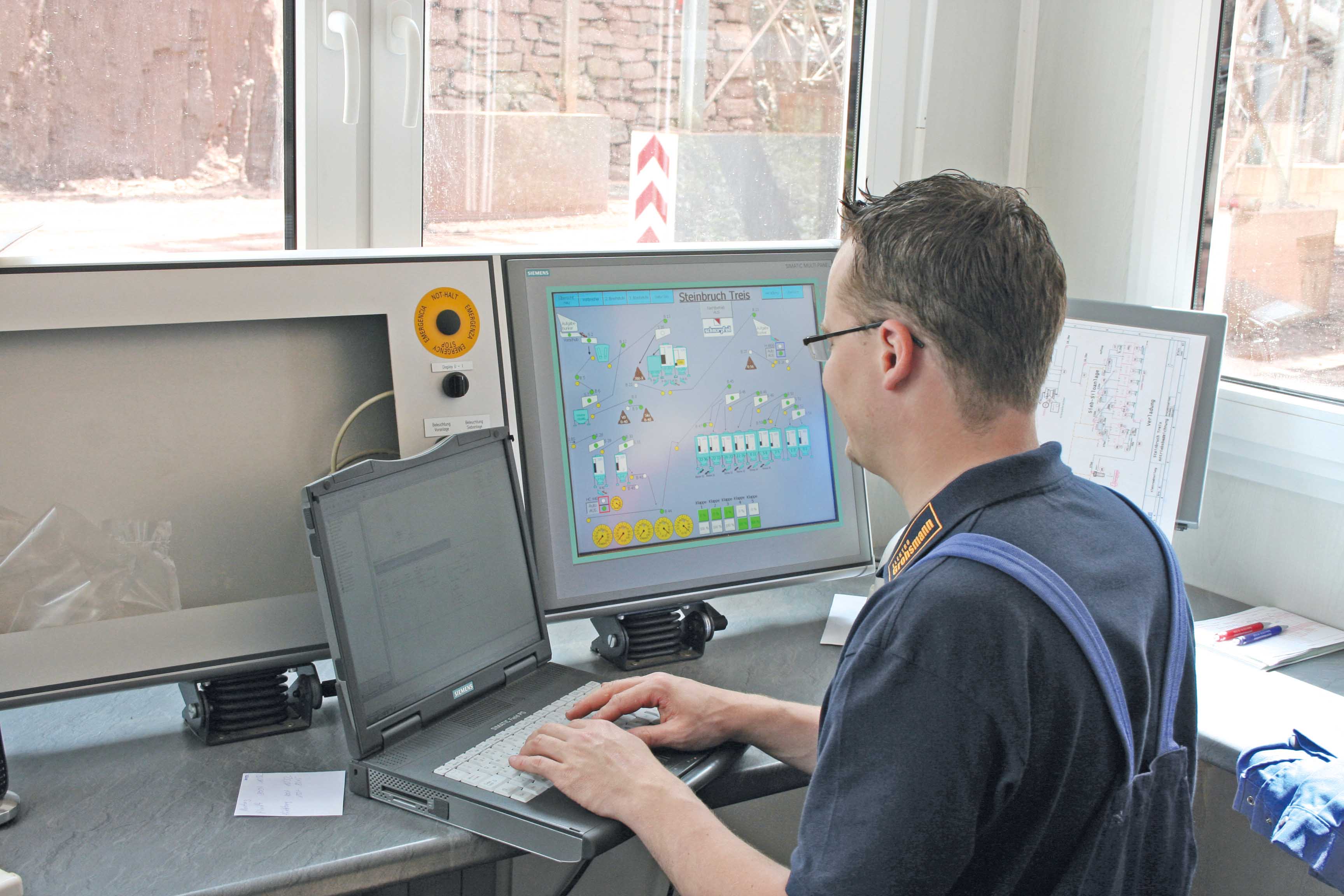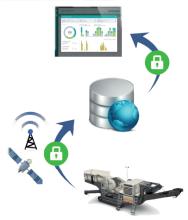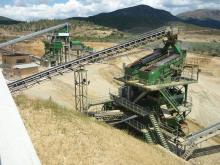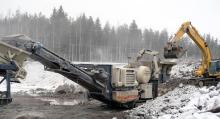
RSSA German quarry is benefiting from the use of one particular innovative plant automation system, while a variety of state-of-the-art plant automation software is delivering huge benefits to quarry and aggregates sector professionals. Guy Woodford reports.
Schnorpfeil operates one of Germany’s most modern quarries in Treis-Karden on the River Mosel. Mosel graywacke, used, among other things, as a road construction material, is quarried there. Using a
The quarry in Treis-Karden was already opened in the 19th century but lay waste for decades until being reactivated by Schnorpfeil after the Second World War. The Mosel graywacke quarried there is not only popular for representative inside and outside masonry work but is also used as a road construction material.
The plant for quarrying the bulk material has been expanded and modernised continuously since being built. One new feature is the possibility of producing quality grit for concrete and asphalt. It now has three breaker stages with intermediate riddle sifters for this purpose. Twelve silos are available for the different grain sizes. The material is loaded directly from these silos onto the customers’ trucks and is weighed continuously during the process. The material flow through the entire system is controlled by a Simatic S7-300. Distributed Simatic ET 200S I/O systems, partly with intelligent IM 151 interface modules, are assigned to the individual units. The plant operation is visualised by two Simatic Multi Panels MP 377. One of these is located in the scales where the customer orders are entered and the unloading from the silos is controlled, the other is in the central control container. The plant operators previously had to monitor the filling levels there to withdraw material from the silos and stockpile it temporarily if necessary. At the same time, the central visualisation systems were used to display diagnostic messages, supplemented locally by a small Operator Panel. Maintenance is an important topic for machines and plants in the quarry because the conditions are especially harsh and the wear on them accordingly heavy. Two workers had always been necessary for maintenance measures because one person could usually not keep an eye on the panel and the fault location at the same time. It was therefore indispensable for troubleshooting that the operator of the stationary panel was assisted by a colleague who watched the fault location.
Expansive plants with complex structures and difficult access as well as high maintenance requirements are a typical area of application for wireless operated Simatic Mobile Panels. However, wireless communication was not used in quarries in the past because it was feared that the radio waves could be disturbed by the large number of steel supports and girders and the steel silos. Elektro Grohsmann in Niederstadtfeld in the Eifel region of Germany, a company experienced in the automation of quarries and industrial plants, accepted the challenge of overcoming this.
With the support of Siemens in Trier, Mario Grohsmann of Elektro Grohsmann designed the wireless communication for a Simatic Mobile Panel 277 via Simatic NET. The consistent networking of all plant sections by means of Profibus or Profinet also allows continuous visualisation and operability of the process. These advantages convinced Schnorpfeil to put Mario Grohsmann’s suggestion into practice. The fact that the entire electrical conversions are provided by one company, from the initial planning and creation of the diagrams and PLC programs, building of the switching systems to the commissioning ensured fast, flexible execution of the project.
Two Scalance Access Points – one on the pre-breaker, one near to the silos – indicate the areas of action and are totally sufficient for operation of the Mobile Panel 277 in all the relevant places in the plant at the present time. A third Access Point is planned for plant expansions. Simatic WinCC flexible for clear visualisation runs both on the Simatic Multi Panels and on the Mobile Panel so that the display and operation of the Mobile Panel are identical with the two stationary panels. The operator has the robust Mobile Panel in the heavy vehicle. It sends him the latest diagnostic messages from the entire plant to which he can respond immediately, to avoid or at least considerably reduce downtime. This is the real advantage because the harsh conditions in a quarry continuously demand minor adaptations to keep the plant running. At the same time, the operator can open the silos to withdraw material with the Mobile Panel if necessary. He can have the current filling volumes displayed without having to go into the control container or the scales where the plant is monitored by Multi Panels. The work which previously occupied two plant operators can now be undertaken easier by one person alone, while the other can carry out more important work. This not only increases the productivity but also the operational safety. “It is much safer when the plant operator can see the appropriate plant section when he is switching functions on and off and can respond quickly without having to rely on the directions of his colleague,” says Kurt Zimmer, the quarry works manager.
As a leading international crushing and screening manufacturer,
The Finnish manufacturer’s popular Lokotrack mobile crushing plants range can now be steered conveniently and safely using remote, wireless controls placed in the cabin of the excavator feeding the crushing plant. The ICr wireless information and control system recently launched by the Finnish company adds safety in excavation work, while the operator does not need to leave the excavator cabin as often as before.
The new ICr wireless information and control system makes the daily work of the operator easier by transmitting steering commands and measurement data to the display attached to the excavator cabin. Using ICr, the basic crusher settings can also be steered.
The most distinctive benefits of the ICr-system include easy assembly to the excavator, stabilising of feed volumes according to the target values and steering of the crusher setting, including wireless data transfer between the units.
Metso has already done ICr installations for tens of units worldwide, and the firm says customers are asking more and more about intelligent solutions for mobile equipment.
One of the first ICr wireless information and control systems is on the Lokotrack LT106 mobile jaw crusher operated by Finnish crushing contractor Pärhä Oy. The LT106 model is the company’s first Metso crushing plant.
Jari Pärhä, who runs Pärhä Oy’s crushing operations, has been satisfied with the Lokotrack LT106 and the ICr system attached to it.
“The remote steering makes it easier to operate the machine and to adjust Lokotrack LT106 capacity to the performance of secondary crushing. By following the display information, the function of the feeder can be easily adjusted.”
According to Pärhä, ICr makes working much safer, while the need to travel between the excavator and the crushing plant is minimised.
Pärhä Oy is owned by Petri and Jari Pärhä, who are developing the company further in its professional production of various sand and gravel products.
One half of the company’s invoicing for its Lokotrack LT106 and ICr-associated work is collected for the production of aggregates for construction projects, and the second half is linked to end products used at a brick works and a ready-mix concrete plant.
The company produces approximately 400,000tonnes/year of aggregates, of which one third is crushed.
The Rovereto, north-east Italy-based firm’s Automatic Feeder Control (AFC) system includes a hardware control unit, where plant production intelligence is stored; various sensors; a remote control web portal; and a local control system for quarry operators. It is, says Ma-estro, like no other technology previously applied in quarries.
Using the sensors and controls installed on different parts of the processing plant and connected to the Ma-estro designed hardware control unit, the AFC system automatically regulates the single material machine feeding; it also recognises varied sizes of material and weighs it on the plant’s conveyors. This enables highly accurate reports to be prepared, not only on tonnes/hour of material being processed, but also on production-related energy costs and how they might be cut. Vitally, the system also informs operators immediately if production stops unexpectedly, saving a great deal of time and money.
Prior to each AFC system sale, Ma-estro agree a price with a potential quarry customer for the firm’s engineers to install and operate it for a month on the customer’s job site. At the end of the month gathered system data allows for a report to be produced looking at the performance of the current aggregates plant set-up. This includes its energy consumption, production costs, fleet make up and efficiency, unusual maintenance costs, plant downtime, how appropriate the workforce level is for current plant production levels, and the optimum production level if the plant was fully operational at all times, coupled with the annual financial benefit of achieving this.
“The AFC system includes sensors on every component of the processing plant. It checks the feeder every two seconds and can automatically change an element of production if necessary, without the need for human intervention” explains Marco Mason, Ma-estro’s sales manager. “This is a crucial advantage with regard to operator safety and lowering production cost due to increased uptime.
“Some people think that having an operator looking at a monitor screen or more than one screen and acting on any problems that appear is automation. That is a manual operation - not automation.”
Mason claims that of leading international crushing and screening equipment manufacturers, only one offers any comparable crushing and screening plant automation package – but says that it comes without the detailed product usage cost breakdown obtained via the AFC system. The leading OEM’s automation package, says Mason, is also only available on its new crushing and screening plants, whereas Ma-estro’s automation system can be fitted on both old and new aggregates processing plants made by all manufacturers.
Ma-estro recently created a web portal that customers can access which enables clients to check on the daily performance of one or more of their processing plants – with a report produced each day based on data covering every five minutes of key working parameters, such as each plant’s energy consumption and each plant’s equipment fleet petrol and diesel costs (after initial average fuel litre costs are manually inputted into the portal software package). Unusual plant maintenance over the course of that working day can also be analysed.
“The web portal can show how production costs can change quite a lot due to factors such as material variability,” explains Manara. “Thanks to the AFC System and by using the web portal, action can be taken quickly by a multiple quarry manager if problems and high costs are identified.”
Currently, Ma-estro has 50 of its AFC systems operating globally – of which 80% are outside the company’s native Italy.
Due to be officially launched in January 2016, SMARTLink is heavyweight crushing and screening brand
From the fleet management fundamentals of knowing the hours and location of their machine to sending health and safety alerts to tracking machine production, SMARTLink can help customers centrally manage their Terex Finlay fleet and, says the Omagh, Northern Ireland-based firm, grow their business.
SMARTLink is said to offer improved machine uptime through accurate engine hours monitoring; the ability to plan routine preventative maintenance and servicing; and enhanced dealer support.
Improved fleet control is said to be secured via SMARTLink’s fuel economy reporting - (cost per tonne if belt-weigh fitted); idle time/ working time monitoring; engine load recording; fleet management reporting; and utilisation reporting.
SMARTLink works by using Global Positioning Satellites (GPS) that provide position information to the machine in the field. The SMARTLink components and software on the machine collects machine data and transmits it to the satellite. The communication satellite transmits information to the SMARTLink data centre. The SMARTLink data centre stores harvested data for the life-time of the equipment. Finally, data can be accessed from the machine in near time via the internet from the SMARTLink data centre.
The SMARTLink system is connected to a network of global positioning satellites and can access and download the machine data regularly via cellular and satellite once the system is activated on the machine.
To access machine data, SMARTLink customers log onto the web-based portal and download the data that they require for in-depth analysis and comparison. The system is said to give customers immediate access and more control over their equipment, providing them with critical and time specific information.
With a customer’s permission, their local Terex Finlay dealer can access their machine on the SMARTLink system to offer enhanced levels of support. Through remote diagnostics, their local dealer can analyse the machine data and even prevent a potential breakdown and production disruption.
SMARTLink-compiled machine fleet information and reports provide customers with an accurate working record in near time of the operational performance of their machine, and helps them to monitor its health and schedule preventative maintenance. The information and reports that can be downloaded include machine location; cautions and alerts; engine work time; engine idle time; engine load levels; working status; maintenance replacement and notifications; operation status; fuel consumption; and tonnage output (when aligned to a calibrated belt conveyor).
Additionally, to improve machine fleet security, SMARTLink enables customers to set operational zones or geofences: set areas that their machine is expected to operate. If the machine is moved out of the geofenced zone, an automatic notification is sent to the customer via text message or email. RSS










